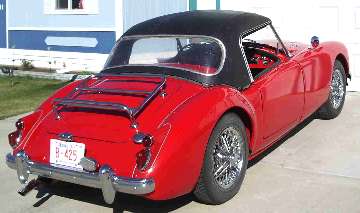The MGA With An Attitude
I will start you off with the "Holy Cow" factor. We know the original factory produced aluminum hardtop for the MGA is quite rare, and also in high demand. The value of a nice one can be quite high, but this might be the record. On July 25, 2004, an original aluminum hardtop for the MGA sold on eBay for $5,205.99. 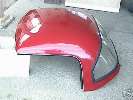
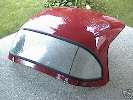
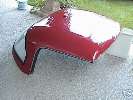
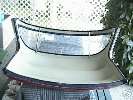
It also appears that many of the "left over" aluminum hardtops were factory installed on the "Deluxe" roadster cars (24 tops or 34% of 1600 "Deluxe" roadsters, and 19 tops or 7% of the Mk II "Deluxe" roadsters). From factory records of rag top colors, these cars seem to have had both ragtop and hardtop. Only 5 cars or 2.8% of Twin Cam roadsters were fitted at the factory with a hard top and 100% of these did NOT have a soft top. Those 5 Twin Cams were the consecutively built 1960 MGA Twin Cam Sebring cars, 4 going to Sebring, and the Canadian copy (which never raced at Sebring). Conclusion from this is that the aluminum top is the correct factory optional accessory for Twin Cams (when rarely installed), and for all 1600 "Deluxe" and early MK II "Deluxe" (as well as all 1500s). But all 1600 (not "Deluxe") roadsters would use the fiberglass accessory top, and perhaps also some late production 1600 MK II "Deluxe" cars. Also if you bought a hardtop from the MG dealer after introduction of the MGA 1600, it would most likely have been a fiberglass top (even if you did drive a Twin Cam or "Deluxe" car). It may bear noting that the MGA Coupe was introduced in September 1956, three months after the first bolt-on hardtop. So the hardtop was NOT a reaction to the fact that the Coupe would go 3 MPH faster on the racetrack because of better aerodynamics. Perhaps the Coupe was a natural follow up to the styling of the first bolt-on hardtop, having a very similar roof line (but different rear glass arrangement). There were some additional aftermarket fiberglass hardtops made by other companies, particularly in the USA where the largest number of MGA were resident. The first MGA I bought in 1968 came with a fiberglass hardtop attached. It was styled similar to the factory fiberglass hardtop, but had no internal or external fabric coverings and didn't fit to the body very well at the back. For restoration information and parts sources, see article TT-130. |

 The factory aluminum hardtop (picture at right) was manufactured from June 1956 to June 1960 by Vanden Plas, a BMC subsidiary, with a reported 1450 units produced. The factory fiberglass hardtop (picture below) was designed (not manufactured) by Universal Laminations, was apparently much cheaper to produce, and was introduced with the start of the MGA 1600 production in May 1959. As such, both aluminum and fiberglass units were in production at the same time for about 14 months.
The factory aluminum hardtop (picture at right) was manufactured from June 1956 to June 1960 by Vanden Plas, a BMC subsidiary, with a reported 1450 units produced. The factory fiberglass hardtop (picture below) was designed (not manufactured) by Universal Laminations, was apparently much cheaper to produce, and was introduced with the start of the MGA 1600 production in May 1959. As such, both aluminum and fiberglass units were in production at the same time for about 14 months. 